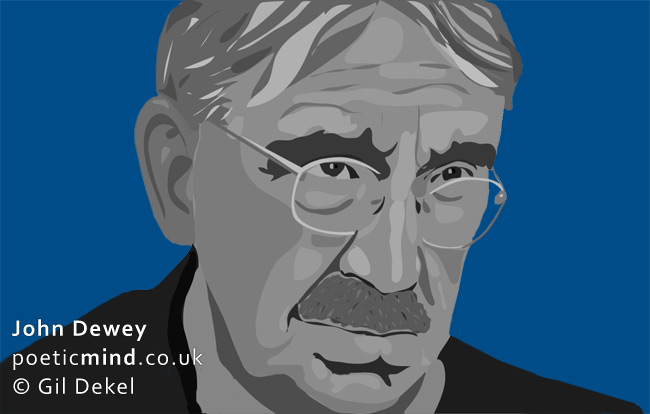
by Gil Dekel, PhD.
Review:
Dewey argues that thinking is a natural automated act, just like breathing and heartbeat are, and therefore it is impossible to teach someone to think. However, it is possible to help develop someone’s thinking, by helping develop a creative, curious and questioning mind. To do so we do not need to teach information in schools, rather encourage stimulus in the form of challenging the external reality.
Instead of teaching data in schools, we can create encouraging environment, within which the already-creative-mind will be stimulated into further creative thinking.
Dewey also argues that the act of thinking equals the act of believing; that in effect when we ‘think’ something we actually ‘believe’ it – thinking is believing.
Summary (with book’s page numbers):
3
Breathing, thinking, and blood circulation are all individual activities – no one can tell you how to do them…
4
Thinking is an automated and unregulated activity.
5
Idea – a mental picture of something which is not actually seen. Thinking – succession of such mental pictures.
In reflective thinking we go outside the succession of the mental pictures.
6
Thinking is synonymous to believing. To say ‘I think that it is going to rain tomorrow’ is equivalent to saying ‘I believe that it is going to rain tomorrow’. When we say ‘Men used to think that the earth was flat’, we refer to a belief system that our ancestors held about the earth – they used to think, i.e. believe, that the earth was flat.
7
And yet, most people today cannot prove that the earth is actually round. We have accepted the idea that the world is round because this is an idea accepted in our cultural and educational system (which might indeed be correct). Yet, we did not examine it ourselves… some scientists did, but most of us did not. We did not take any active part in the process of framing this belief. Therefore, this belief is prejudice; it is a pre-judgment. It is not a conclusion reached by us as a result of observing, collecting and examining evidence.
8
The ancient belief that the world is flat was developed as people believed that they can see the full picture with their eyes. The belief in the flatness of the earth was based on some evidence observed: what people could actully see with their eyes. People saw a flat earth and an end to it in the horizon of their vision. Yet, people’s vision is limited, and what they saw was not further checked. Columbus challenged these traditional theories; he doubted and inquired.
14-15
A thinking process begins with a dilemma that suggests alternatives, and so thinking is evoked by confusion.
35
There must be resources that are already active in the mind, since we cannot force a brain to think out of nothing. We cannot teach one to think. Thinking is natural. There is a natural resource that ‘activates’ the mind.
36
Every living creature is in constant interaction with its surroundings, and is in a process of give and take.
37
Wordsworth – ‘the eye must see, the ear must hear, the body feels’. All our senses are acted upon by the environment. A child’s whole body is curious, but as we grow, curiosity is removed from thinking.
38-39
Curiosity becomes social, as the child learns that s/he can appeal to others by acting certain way. Curiosity becomes intellectual, and is lost.
Francis Bacon – ‘we must become as little children in order to enter the kingdom of science’. We can adopt the open-mind and flexibility to accept wonder as children do.
52
Wonder is the author of science and philosophy. External monotony and internal routines are the enemies of wonder. The surprising and unexpected stimulate wonder.
53
Schools’ classrooms are set up as monotonous uniformity. The desk chairs are in set position, and the same textbooks are read for long periods.
55-56
There is no single uniform power of thought, but multitude of observations, memories, imagination, and common sense, that together comprise thoughts. To develop thinking we need to develop curiosity and the habit of exploring and testing. These will increase questioning and the love of inquiry.
The method to develop reflective thought is to develop curiosity.
284-285
In play, the main interest of the players is centered around the activity of the game itself, and not the outcome. In play, the sequence of deeds, images, and emotions, is sufficient. At work, the end result holds the most attention.
286
A balance of play and work means we set the mind free to follow the unfolding process of the subject on its own account, with no perceived beliefs or arbitrary restrictions. A free mental-play is a serious activity. It is an earnest way of following the true nature of a subject. It is not carelessness.
‘How We Think’ published 1933 by D.C. Heath and Company, Massachusetts, USA.
14 May 2011. Last update 23 Aug 2016.
© Gil Dekel.



 - Reading with Natalie, book here...
- Reading with Natalie, book here...